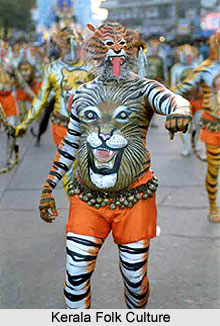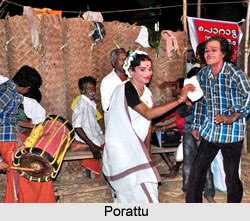 Folk theatre of Kerala, as generally believed, evolved out of religious ceremonies. However, there are evidences to prove that theatre is indeed older than religion. Very old magical rituals could not have been connected with religion, if not Man had performed `rain dance` and imitation of `animal hunt` as part of his daily ritual. A somewhat similar development, though not having its roots at imitation of animal hunt, can also be detected in the Indian state of Kerala also.
Folk theatre of Kerala, as generally believed, evolved out of religious ceremonies. However, there are evidences to prove that theatre is indeed older than religion. Very old magical rituals could not have been connected with religion, if not Man had performed `rain dance` and imitation of `animal hunt` as part of his daily ritual. A somewhat similar development, though not having its roots at imitation of animal hunt, can also be detected in the Indian state of Kerala also.
The folk drama, kothamooriyattom, might have come from fertility rites like gopuja. Kothamooriyattom is one among the few fertility plays that are still ubiquitous in north Malabar. The folk theatre of Kerala is very closely bound to religious rituals, and pure forms of theatre are very rare. Though Kaikottikkali, Kolkali, Dappumuttukkali, etc., are art forms that seek to entertain, but they are still performed as part of a particular ritual. Kaikottikkali is associated to Tiruvathira, Kolkali is part of the religious festivities at Vettakkorumakan temple and Dappumuttukkali is performed as a ritual in mosques.
There are some folk dramas like Kurathiyattom, Porattunatakam, Kakkarassinatakam, etc., that are actually not connected with the rituals or even the artistic traditions of Indian state of Kerala. Their plot structures, manner of presentation, linguistic expressions and characters illustrate the influence of Tamil culture and are popular in those districts that lie close to the state. The Porattunatakam of Trissoor shows features that are strikingly similar of the Porattunatakam of Palakkad that has a heavy Tamil cultural accent. The Kurathiyattom of Kannur has resemblances with the lives of the nomadic kuravas and kurathis of Tamil Nadu. Pankali, a version of Porattunatakam, exists only in Palakkad.
The folk theatre of Kerala, which is of serious importance, is actually ritualistic drama. This hold special features of artistic tradition of Kerala. The content of the plays generally have a compact plot, with proper beginning, middle and end, antithetical characters, logical and orderly development of the plot, four styles of acting, audience participation, environmental acting, improvisation in acting, creation of specific moods, etc., are some of the unique features of the ritualistic theatre of Kerala. The acting is most often realistic.
 Apart from these, there are certainly some folk dramas that entail only one style of acting Vannankoothu, Malayikoothu, etc., of Kannur adopt the narrative mode of acting. The theme and plot of Malayikoothu, which provides an entertainment interlude in Theyyattom with women narrating and enacting stories behind the wall of the snake shrine, is actually taken from the Mahabharata. And the Vannankoothu, takes on a unusual style. In it, two characters - Ankoothu and Penkoothu, come on to the stage and recite slokas as well as stylized prose in chaste Malayalam.
Apart from these, there are certainly some folk dramas that entail only one style of acting Vannankoothu, Malayikoothu, etc., of Kannur adopt the narrative mode of acting. The theme and plot of Malayikoothu, which provides an entertainment interlude in Theyyattom with women narrating and enacting stories behind the wall of the snake shrine, is actually taken from the Mahabharata. And the Vannankoothu, takes on a unusual style. In it, two characters - Ankoothu and Penkoothu, come on to the stage and recite slokas as well as stylized prose in chaste Malayalam.
Porattu is an important component of the folk drama of Kerala. It is performed as part of the ritualistic dramas like padayani, kendronpattu, poorakkali, etc., but has an independent existence because it is totally free of ritualistic elements.
Although the state of Kerala boasts of many types of folk theatre, but technically very few actually can be called drama. At the same time, there are other forms that have several qualities of the theatre. A study of the folk theatre of Kerala will thus not be completed if they are not taken into consideration.




